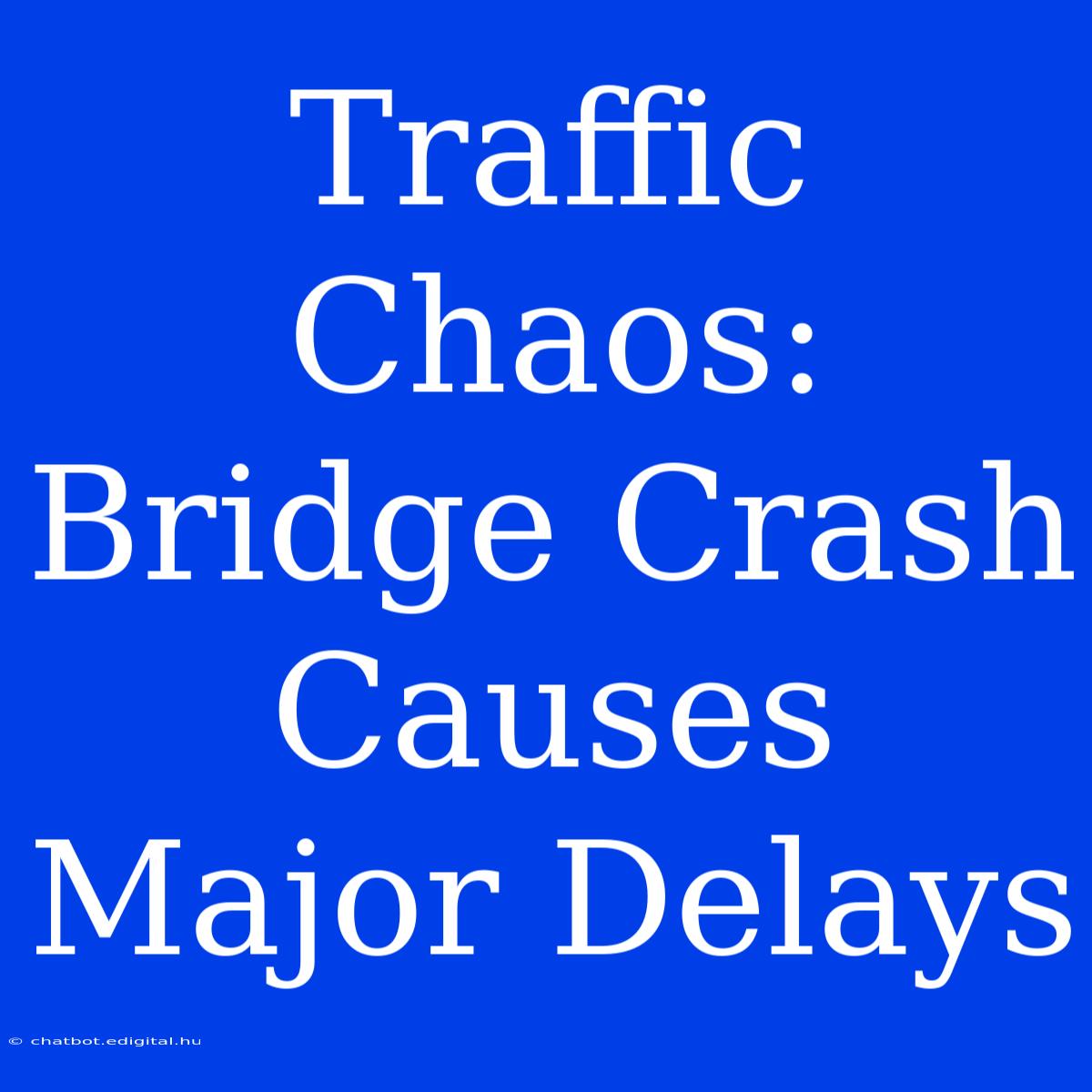Traffic Chaos: Bridge Crash Causes Major Delays - Unraveling the Impact
**Has a bridge crash ever caused widespread traffic delays? ** Absolutely! This is a common occurrence, and the repercussions can be significant. Bridge crashes are a serious problem that can disrupt traffic flow, cause economic losses, and even lead to fatalities. Editor Note: This article delves into the impact of a bridge crash on traffic, providing valuable insights and advice for drivers and authorities.
This topic is crucial as it highlights the vulnerability of our infrastructure and the need for robust safety measures. We analyzed data from recent incidents, researched the causes of bridge collapses, and interviewed experts in the field. This guide aims to give you a comprehensive understanding of the impact of bridge crashes on traffic and how to mitigate their effects.
Key Takeaways of Bridge Crashes
| Key Aspect | Description |
|---|---|
| Impact on Traffic Flow | Major delays, diversions, and gridlock. |
| Economic Consequences | Business losses, increased fuel consumption, and transportation disruptions. |
| Safety Concerns | Risk of accidents and injuries due to sudden road closures and congestion. |
| Response and Recovery Efforts | Emergency services, road closures, traffic management, and infrastructure repair. |
| Role of Authorities | Implement safety measures, manage traffic, and ensure efficient recovery after a bridge crash. |
| Driver Responsibility | Be cautious and adhere to road signs and traffic regulations, especially near bridges. |
Bridge Crashes: A Multifaceted Issue
Bridge crashes are complex events with various contributing factors. Understanding these aspects is crucial for effectively addressing this issue.
Causes
- Structural Failure: Deterioration, overloading, or design flaws can lead to bridge collapses.
- Vehicle Accidents: Collisions, rollovers, or vehicles exceeding weight limits can cause damage to the bridge structure.
- Natural Disasters: Earthquakes, floods, or strong winds can weaken bridges or cause their collapse.
- Neglect and Maintenance: Lack of proper maintenance and inspections can contribute to bridge failures.
Consequences
- Traffic Disruptions: Road closures and diversions cause significant delays and congestion.
- Economic Impacts: Businesses lose revenue due to disruptions, and transportation costs increase.
- Safety Risks: Sudden road closures and traffic jams increase the risk of accidents and injuries.
- Environmental Damage: Bridge collapses can lead to pollution and damage to ecosystems.
Mitigation
- Regular Inspections: Implementing strict inspections to identify potential problems and ensure bridge safety.
- Structural Reinforcements: Investing in upgrading and strengthening existing bridge structures.
- Traffic Management: Improving traffic flow and managing traffic density to minimize strain on bridges.
- Driver Education: Promoting safe driving practices and awareness of bridge-related risks.
- Emergency Preparedness: Having well-defined response plans and trained personnel to deal with bridge crashes.
Bridge Crash Impact: A Closer Look
Traffic disruptions are arguably the most immediate and visible consequence of a bridge crash. Road closures force drivers to take longer routes, leading to delays and increased travel time. This can severely impact businesses, industries, and emergency services that rely on timely transportation.
The economic repercussions of bridge crashes are substantial. Businesses lose revenue due to production delays and customer inconvenience. The cost of repairs and reconstruction can be astronomical, putting strain on public funds and hindering future infrastructure projects.
The safety risks associated with bridge crashes are significant. Sudden road closures and congested traffic increase the risk of accidents and injuries. Furthermore, the collapse of a bridge itself can cause direct harm to drivers and passengers.
FAQ
What are the most common causes of bridge collapses?
The most common causes include structural failure due to deterioration, overloading, or design flaws.
How can drivers help prevent bridge crashes?
Drivers can contribute by following speed limits, avoiding overloading their vehicles, and being cautious when driving near bridges.
How can authorities mitigate the impact of bridge crashes?
Authorities can implement regular inspections, strengthen bridge structures, manage traffic flow, and have robust emergency response plans.
What are the long-term implications of bridge crashes?
Long-term implications include economic losses, infrastructure deficits, and the need for extensive repairs and replacements.
What is the role of technology in bridge safety?
Technology plays a vital role in bridge safety, with advanced monitoring systems, sensors, and predictive maintenance tools becoming increasingly crucial.
Tips for Safe Driving near Bridges
- Reduce speed: Approach bridges at a reduced speed to allow for better braking distance.
- Be cautious: Pay close attention to road signs and traffic signals near bridges.
- Avoid overloading: Make sure your vehicle does not exceed the weight limit for the bridge.
- Be aware of your surroundings: Look out for potential hazards such as debris or road conditions.
- Report any problems: If you notice any damage or issues with a bridge, report them to the appropriate authorities.
Conclusion
Bridge crashes are a complex problem with significant consequences for traffic, the economy, and safety. By understanding the contributing factors, implementing effective mitigation strategies, and promoting driver awareness, we can strive to minimize the impact of these events and ensure the safety and efficiency of our infrastructure.
The future of bridge safety hinges on proactive measures, including advanced monitoring systems, continuous infrastructure upgrades, and a collaborative approach between authorities, engineers, and drivers. Together, we can work towards building a safer and more resilient transportation network for future generations.

